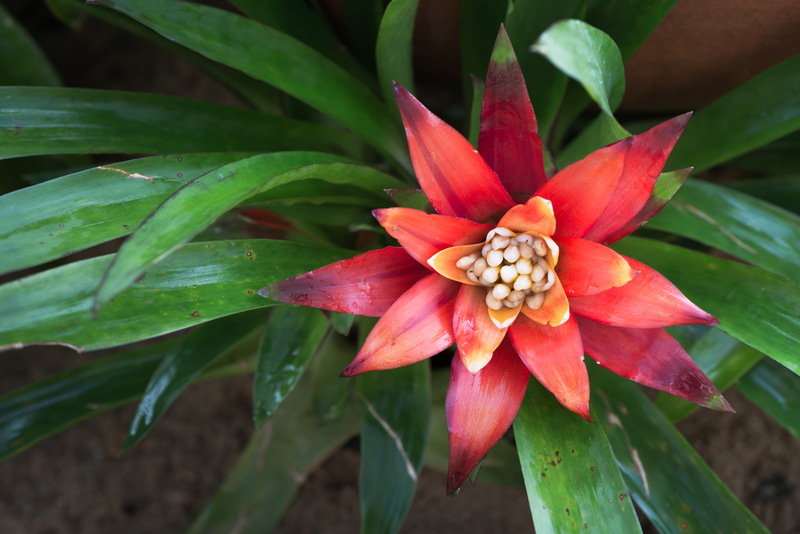From Seed to Sprout: Unveiling the Path to a Perfect Herb Garden
Posted on 09/09/2025
From Seed to Sprout: Unveiling the Path to a Perfect Herb Garden
Are you yearning for a fresh touch of greenery in your home or backyard? Imagine plucking fragrant basil, soothing mint, or zesty cilantro straight from your very own herb garden. Cultivating culinary herbs does more than boost your cooking--it's a rewarding, eco-friendly hobby that connects you to nature and fills your space with vitality. Follow this comprehensive guide to transform humble seeds into a vibrant herbal sanctuary.
Why Grow Your Own Herb Garden?
There are countless reasons to cultivate an herb garden from seed. Fresh herbs elevate meals with intense flavors while offering impressive nutritional and medicinal benefits. Growing herbs at home is economical, environment-friendly, and offers endless satisfaction as you nurture tiny seeds into lush, fragrant plants.
- Cost-effective: Seeds are a fraction of the price you'd pay for supermarket bundles.
- Quality control: You decide if your garden is organic and pesticide-free.
- Aesthetic appeal: Herbs are beautiful additions to any windowsill, balcony, or backyard.
- Therapeutic value: Engaging with plants reduces stress and fosters creativity.
Selecting the Best Herbs for Your Garden
The first step on the journey from seed to sprout is choosing the right herbs for your culinary needs and growing conditions. Consider your local climate, available space, and how you plan to use your fresh herbs. Some popular choices for beginners include:
- Basil: Perfect for pesto, salads, and Italian dishes.
- Mint: Refreshing for teas, desserts, and cocktails.
- Parsley: A versatile garnish for a wide range of cuisines.
- Thyme: Adds depth to soups and roasted meats.
- Cilantro: Essential in salsas and Asian and Latin American recipes.
- Rosemary: Aromatic and resilient, great for grilled dishes.
Tip: If you're short on space, start with compact or dwarf herb varieties that flourish in containers.
Preparing the Perfect Location for Your Herb Garden
Assessing Light Requirements
Most herbs thrive in full sunlight (at least 6 hours daily), which encourages robust growth and strong flavor. Evaluate your garden area for the best exposure, understanding that:
- Most Mediterranean herbs (oregano, rosemary, thyme) love sun-soaked spots.
- Leafy herbs (mint, parsley, chives) tolerate partial shade.
If outdoor space is limited, a sunny windowsill or balcony can still support a bountiful indoor herb garden.
Choosing Between Ground, Raised Beds, or Containers
The path to a successful herb garden begins with selecting the right format:
- In-ground beds: Offer plenty of room and natural drainage but may require soil improvement.
- Raised beds: Warm up quickly in spring and keep soil loose, ideal for deep-rooted herbs.
- Containers: Provide flexibility, mobility, and control. Perfect for patios, apartments, and indoor gardening.
All options can produce exceptional results; choose the setup that best fits your space, lifestyle, and aesthetic goals.
Soil Preparation: Laying the Foundation for Healthy Herbs
Herbs flourish in well-draining, nutrient-rich soil. Before planting, ensure your soil is:
- Loamy and rich in organic matter.
- Free of rocks and compacted clumps.
- pH-neutral to slightly alkaline (6.0 to 7.5).
Improve garden soil by mixing in compost or aged manure, or opt for ready-mixed organic potting soil in containers. Avoid heavy, waterlogged soils, as most herbs cannot handle "wet feet."
Container Tips for Herb Gardens
- Ensure pots have drainage holes.
- Use high-quality soil-less potting mix for best results.
- Group herbs with similar water needs together.
Choosing and Sowing Your Herb Seeds
Where to Purchase Herb Seeds
To jumpstart your journey from seed to sprout, purchase seeds from reputable nurseries or online seed providers. Look for:
- Organic and non-GMO options for natural gardening.
- Varieties suited to your region's climate.
- Freshness dates--older seeds may have lower germination rates.
How to Start Seeds Indoors
Many herbs benefit from an early indoor start, especially in cooler climates.
- Fill small seed trays or pots with moistened seed-starting mix.
- Sow seeds at recommended depth (usually 1/8 to 1/4 inch deep).
- Gently mist the surface and cover with a plastic dome or clear wrap to maintain humidity.
- Place trays in a warm (65-75?F), bright spot--bottom heat from a seed-starting mat helps speed germination.
- Once sprouts emerge, remove the cover and provide plenty of indirect light, rotating trays daily for even growth.
- Thin seedlings to prevent crowding, keeping the strongest plants.
Note: Basil, parsley, dill, and cilantro all respond well to indoor sowing.
Direct Sowing Outdoors
Some herb seeds prefer direct planting into garden beds or containers after the threat of frost has passed. These include:
- Cilantro
- Dill
- Chervil
- Fennel
To direct sow: Rake soil smooth, moisten lightly, sow seeds at listed depths, and cover gently. Water with a fine spray to avoid washing away tiny seeds.
From Seedlings to Lush Herb Plants: Nurturing Your Garden
Watering Wisely
- Most herbs prefer slightly dry conditions--overwatering is a common mistake.
- Let soil surface dry between waterings.
- Water at the base to help prevent fungal diseases.
- Container herbs may require more frequent watering, especially in summer.
Fertilizing Your Herb Garden
Herbs don't demand heavy fertilization. Overfeeding can dilute essential oils and diminish flavor. Apply a balanced organic fertilizer or compost tea monthly, or use slow-release granules for containers.
Pruning and Pinching for Bushier Growth
- Regularly pinch back growing tips to encourage branching and fuller plants.
- Remove flower buds from annual herbs like basil and cilantro to prolong tasty leaf production.
- Harvest leaves often but avoid stripping more than one-third of a plant at a time.
The more you harvest, the more your herbs flourish!
Pest and Disease Management for a Thriving Herb Garden
Herbs are generally resilient, but a few common troubles can arise:
- Aphids and whiteflies: Use insecticidal soap or blast with water in early morning.
- Fungal diseases: Avoid overhead watering, provide good air circulation, and space plants properly.
- Slugs and snails: Handpick or use organic barriers like crushed eggshells.
Practicing crop rotation, removing plant debris, and encouraging beneficial insects (such as ladybugs) help maintain healthy, organic herb gardens.
Harvesting and Storing Your Fresh Herbs
Harvest herbs early in the morning, just after the dew has dried but before the sun evaporates their fragrant oils.
- Use sharp scissors or pruners for a clean cut.
- Gather small amounts regularly to encourage continuous growth.
- Remove flower buds unless specifically growing for seeds or blooms.
To store fresh herbs:
- Bundle and hang upside down in a cool, dry, well-ventilated space for air drying.
- Freeze chopped herbs in ice cube trays with water or olive oil.
- Store short-term in an airtight container lined with damp paper towels in the refrigerator.
Tip: The freshest flavors come from using herbs within a few days of harvest.
Creative Designs for the Perfect Herb Garden
Themed Herb Gardens
- Pizza garden: Tomato, basil, oregano, thyme, and chives.
- Tea garden: Mint, chamomile, lemon balm, lavender.
- Medicinal garden: Echinacea, calendula, sage, peppermint.
Companion Planting
Many herbs actually repel insect pests and enhance neighboring plants' growth. For example, basil and tomato are ideal partners, as basil repels tomato hornworms and boosts tomato flavor.
Vertical and Indoor Herb Gardens
- Install wall-mounted planters for trendy, space-saving vertical gardens.
- Hang pots from railings, roofs, or balconies to maximize sun exposure.
- Try hydroponic or aquaponic kits for futuristic, soil-free herb gardening indoors.
Common Challenges--and How to Overcome Them
- Leggy seedlings? Increase sunlight or use a grow lamp.
- Yellowed leaves? Check drainage and ease back on watering.
- Bug damage? Inspect plants daily and treat at first sign of pests (see above).
- Slow growth? Gently fertilize with compost tea or organic feed.
Persistence and attention to detail are your keys to a perfect herb garden!
Seasonal Tips for Ongoing Success
Herb gardening is an ongoing journey. Follow these seasonal strategies for year-round bounty:
- Spring: Start seeds indoors or sow hardy varieties outdoors. Prepare soil and clear beds.
- Summer: Fertilize lightly, water more often, harvest regularly, and pinch flower buds.
- Autumn: Dry or freeze herbs for winter. Cover perennials with mulch when frost approaches.
- Winter: Grow herbs indoors with adequate light or use a hydroponic system.
Frequently Asked Questions About Building a Perfect Herb Garden
Can I grow an herb garden in a small apartment?
Absolutely! Container gardens fit on windowsills, balconies, or even kitchen shelves. Compact herbs like basil, chives, mint, and parsley flourish indoors with a bit of light and care.
How long do herb seeds take to sprout?
Depending on the variety and conditions, most herb seeds germinate within 5 to 21 days. Basil and cilantro sprout rapidly; parsley can take up to 4 weeks.
How often should I fertilize my herb garden?
Once a month is generally sufficient for outdoor beds. Container herbs benefit from light feeding every 3-4 weeks since nutrients wash out faster.
Conclusion: Reap the Rewards of Your Herb Gardening Journey
From seed to sprout, cultivating the perfect herb garden is a journey filled with discovery, beauty, and flavor. With expert care, a bit of patience, and the right conditions, anyone can transform a handful of seeds into a thriving oasis teeming with tasty, aromatic herbs.
Start small or go wild with themed gardens and creative containers. Keep experimenting, harvest often, and watch as your confidence--and your plants--grow. Soon, every dish you create will be a celebration of your own homegrown herbs, picked fresh and full of life!
Ready to unveil your green thumb and start your own herb garden from seed? Grab your packets, roll up your sleeves, and let your herbal adventure begin!





